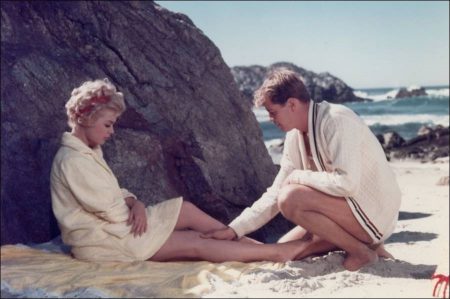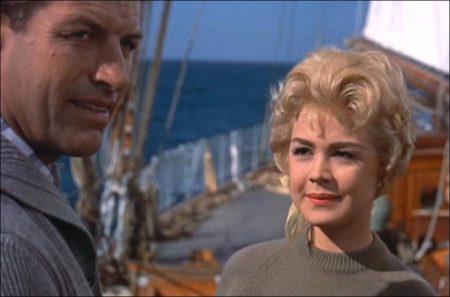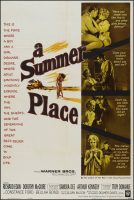Taglines: The inn… The guests… The sensations of the frankest story ever filmed.
A Summer Place movie storyline. The Hunter family has long owned a mansion on Pine Island, a summer resort located off the Maine coast. Bart Hunter’s now deceased father was able to open the mansion for free when Bart was younger, but current owner Bart, a drunkard and weak man, must now live there year round for financial survival with his wife Sylvia and their late teen-aged son Johnny, the family which is barely able to eke out a living with the mansion now as a year-round inn which is in an extreme state of disrepair.
Bart and Sylvia are in a quietly unhappy marriage due largely to Bart’s drinking. The Buffalo-based Jorgensons – husband Ken Jorgenson, his wife Helen Jorgenson and their late teen-aged daughter Molly Jorgenson – have rented rooms at the inn for the summer, while Ken looks for a summer house on the island. Ken lived on the island twenty years ago, he actually a working class lifeguard for Bart’s father at that time.
Ken is now a self-made millionaire as a research scientist, who had never been back to the island until now. Ken and Helen too are in an unsatisfying marriage, Helen, a shrew and prude, who seems to hate and mistrust anything and everything, including her husband and daughter. Helen only seems concerned with public perception that their lives are perfect.
Upon first meeting, Johnny and Molly fall in love. Meanwhile, Ken and Sylvia rekindle a romance from twenty years earlier, they uncertain if Bart knew at the time of their relationship, which did not last because of the differences in their social background. The two romances have a rocky road to potential happiness. Helen does not trust either Johnny or Molly to be morally proper.
Ken and Sylvia know that their respective spouses will never consent to divorce, and if they do will do whatever they can so that they will never get to see their children again. And despite knowing that their respective parents are unhappy in their marriages, Johnny and Molly do not approve of a liaison between his mother and her father.
Regardless, Ken and Sylvia want to provide their children with as much love and guidance as possible, including encouraging them to follow their hearts while not getting into trouble, a message which may not be heard if only because of Johnny and Molly believing that what they are doing is disgusting, and because of Johnny and Molly’s own raging hormones.
A Summer Place is a 1959 American romantic drama film based on Sloan Wilson’s 1958 novel of the same name, about teenaged lovers from different social classes who get back together 20 years later, and then must deal with the passionate love affair of their own teenaged children by previous marriages. Delmer Daves directed the movie, which stars Richard Egan and Dorothy McGuire as the middle-aged lovers, and Sandra Dee and Troy Donahue as their respective children. The film contains a memorable instrumental theme composed by Max Steiner, which spent nine weeks at number one on the Billboard Hot 100 singles chart in 1960.
The film was shot in Pacific Grove and around the Monterey Peninsula. Sloan Wilson wrote the first screenplay, which covered the 22-year span of the novel. Delmer Daves focused the new draft on one year. Daves said: “I have two kids who are just about the same age of these two in A Summer Place and I know how difficult communication between generations can be.
And while this may sound corny, it can be assisted by love and understanding. Amid some rather tempestuous social activities, this is what we are trying to demonstrate. That there are two affairs may sound sensational, but that’s not the point. We have received the approval of the Johnstone office, because the intent of the picture is a moral one. Frankness and impatience will help pull the cork on a situation blocked by intolerance. What we are trying to do is dramatise that pulling of the cork.”
Some exterior and interior scenes involving Ken and Sylvia’s beach house were filmed at Frank Lloyd Wright’s Clinton Walker House, built in 1948. In the film, Sylvia tells Molly that Wright designed the house, ostensibly located on the East Coast near the movie’s “Pine Island” location (since Molly and Johnny drive from Pine Island to the house after being sent away by the justice of the peace).
In reality, Walker House is located on the beach side of Scenic Road on Monterey Bay in Carmel-by-the-Sea, California. The real house has only one level, although in the movie, the house is depicted as if it has a lower level at the same level as the beach. Additional scenes were filmed at the Honeymoon Cottage located at Mission Ranch in Carmel.
The 1960 instrumental hit “Theme from A Summer Place”, composed by Max Steiner, was used in the film as a secondary musical theme (not the main title theme) for scenes featuring Molly and Johnny. The version used in the film was recorded by Hugo Winterhalter. It was later arranged and recorded by Percy Faith and performed by his orchestra, enriching and improving on the original.
In 1960, the Percy Faith version reached number one on the Billboard Hot 100 chart for nine consecutive weeks, a record at that time.[2] The theme has been covered in instrumental or vocal versions by numerous other artists, including The Lettermen, Andy Williams, Cliff Richard, Julie London, Billy Vaughn, Joanie Sommers, and The Ventures, and has been featured in many other films and television programs.
A Summer Place (1959)
Directed by: Delmer Daves
Starring: Richard Egan, Dorothy McGuire, Sandra Dee, Arthur Kennedy, Troy Donahue, Constance Ford, Beulah Bondi, Jack Richardson, Martin Eric, Cheryl Holdridge, Lewis Martin
Screenplay by: Delmer Daves
Cinematography by: Harry Stradling
Film Editing by: Owen Marks
Costume Design by: Howard Shoup
Set Decoration by: William L. Kuehl
Art Direction by: Leo K. Kuter
Music by: Max Steiner
MPAA Rating: None.
Distributed by: Warner Bros. Pictures
Release Date: November 18, 1959 (United States)
Visits: 238


